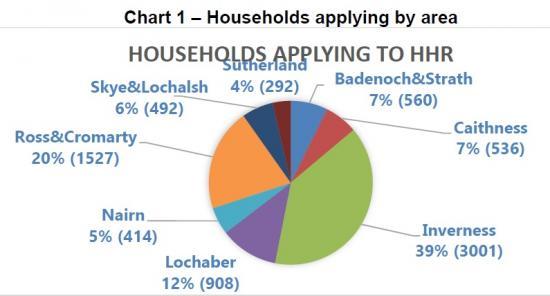Inverness Has Huge Waiting List For Social Housing But Caithness and Sutherland have very low lists
2nd September 2020

The Housing and Property committee of Highland council at its meeting on 9 September 2020 will discuss housing issues including he waiting lists for homes
Housing Demand
There were a total of 7,785 ‘Housing' and ‘Transfer' List applications held at the end of
2019/20 compared to 7,890 in 2018/19. Need for affordable housing does not appear to be significantly reducing. 72% of these applicants are looking to move as ‘new' (not transferring) tenants. They are mostly privately renting or living with family. Almost 1,000
households are living in temporary ‘homeless' accommodation or are ‘homeless at home'. Many of these homeless households, particularly in Inverness, are young people or families with children.
The continuing need for smaller sized properties is clear. Half of all applicants are single people and only 10% are couples. Four of 10 applicants are families. This varies across Highland.
The highest demand for housing in terms of the number of applications remains Inverness (where 39% of all applicants want to be housed), followed by Ross and Cromarty (20%) and Lochaber (12%).
However, whilst around 4 out of 10 applicants are seeking housing in the Inverness area, the lack of housing availability means that less than 3 out of 10 (30%) lets are made there.
The pressure on housing varies across Highland. This means that applicants whose need for housing is less acute are able to receive offers of housing more quickly in some areas than applicants with more acute housing needs in other areas. Analysis of the number applying for each house being let indicates that the pressure on social rented housing is greatest in Nairn, followed by, respectively, Badenoch and Strathspey, Inverness and Mid Ross. Housing pressure in those four areas is far greater than the Highland average.
Pressures also vary significantly across communities within areas for example within the communities of Aviemore and West Lochaber. It continues to be relatively easier to access affordable housing in Caithness and in areas of Sutherland.
---------------------------------------------------------------------
Meeting Demand
Across Highland, 1,800 households were housed in 2019/20. The increase year-on-year is a result of the new build programme. It should be noted that around 25% of offers were refused and officers are analysing the reasons for this.
The majority of lets continue to be into Council housing (62% of lets), followed by Albyn HS (21%); Cairn HA (7%); Lochaber HA (4%); Lochalsh & Skye HA (3%) and Pentland HA (3%).
Social rented housing providers have a legal duty to give a ‘reasonable preference' to priority groups when allocating housing. This includes households who have nowhere safe and secure that they can reasonably stay and so are homeless, and households
who are living under unsatisfactory conditions and who have unmet housing needs.
The HHR partners are continuing to meet their duties and house households who are homeless. Across Highland 718 lets, 39% of all lets went to households with points which reflected their homeless status. Although this is similar to previous years, applications show that the number of households becoming homeless is increasing.
6.5 In areas where there is a greater lack of housing homeless points play a more significant role in leading to a let. For example, 55% of all Inverness areas lets were to homeless households (excluding transfers, this equates to 75% of ‘Housing List' lets).
6.6 Across each of the different areas, all the Highland Housing Register landlords house a similar proportion of homeless households. This demonstrates the important role of Highland's housing associations in meeting the wide range of social housing needs including homelessness.
Analysis of the proportion of lets to the other various housing needs groups, compared to demand from applicants with those needs, shows that the HHR Allocations Policy is largely meeting its objectives to provide housing to those with the greatest needs. A
quarter of those who were housed had been living in housing which was unsuitable due to their health and social care needs. A quarter had been living in overcrowded housing.
As well as approaches directly from applicants, HHR partners are committed to assisting with other policy priorities. Twenty-five households were helped to move into their first ‘independent living' tenancy, many via our Protocol with NHS Highland, as they have
complex continuing health care and support needs. Nineteen care experienced young people were housed through the Highland Protocol which supports our Corporate Parenting commitments and duties.
Over 8 out of 10 applicants housed had additional points which recognised they had a particular ‘Need to Reside’ in that community because either because they work or are already established there; or are providing or receiving family care or support.
We monitor equalities to make sure we are providing equality of access and no discrimination. In line with the previous year, 76% of applicants described themselves as Scottish. This group accounted for 79% of those housed applicants; 7% of lets went to non-British/White households; and around 3% of lets went to other ethnic minorities. The proportion of lets to households describing themselves as disabled matched the proportion of applicants doing so (18% of lets and applicants).
Read the full paper at https://www.highland.gov.uk/meetings/meeting/4309/housing_and_property_committee
Related Businesses
Related Articles
Council welcomes Visitor Levy flexibility plan
The Highland Council welcomes moves by the Scottish Government to introduce greater flexibility on how it could design a Visitor Levy Scheme for consultation. The Visitor Levy (Scotland) Act 2024 currently provides local authorities with discretionary powers to implement percentage-based levies following statutory consultation.Highland Council is reaching out for views to shape its next 26/27 budget.
As it looks to set out its forthcoming priorities, the council is seeking involvement from members of the public, including businesses, community groups, parents, and young people. All their opinions are going to be crucial in deciding how Highland Council will take on its budget challenge for 2026-2027.Have your say in Thurso's future £100million investment by attending public consultation events
Thurso is to benefit from £100m investment in education and community facilities and are rolling out the first phase of public consultations on 9 and 10 December 2025. The Highland Council is inviting people that live, work, or study in Thurso, to come along to the public consultation events to have their say; this is an opportunity to help shape the future of Thurso, to gather views and ideas.Finding new owners for empty homes - Scheme launched to help return more empty homes to active use
A new online portal has been launched to bring empty homeowners together with prospective buyers or developers with the aim of facilitating more properties to be used as homes again. Covering the whole of Scotland, this builds on the success of local pilots, referred to as "matchmaker schemes".Consideration for short term let control area in Skye and Raasay
Steps towards introducing a short term let control area have been considered by Highland Council's Isle of Skye and Raasay area committee. On Monday (1 December 2025) the committee heard evidence to justify the grounds for the introduction of a Short Term Let Control Area covering all or part of Skye and Raasay.Workforce North event spotlights Highland economy
EMPLOYERS and educators from across the Highlands have gathered to hear how a new initiative is aiming to transform the region's economy. Workforce North - A Call to Action brought together business leaders and teachers from primary and secondary schools from across the Highland Council area with a wide range of partners geared towards education, learning and skills development at Strathpeffer Pavillion.
Council calls for meaningful engagement from Home Office Over 300 Asylum Seekers Being Sent to Inverness
The Highland Council continues to call for meaningful engagement from the Home Office over its plans to temporarily accommodate up to 300 adult male asylum seekers at Cameron Barracks, Inverness. It follows an email on Monday from Alex Norris MP, Minister for Border Security and Asylum, to Council Leader, Raymond Bremner, which failed to answer questions raised by the Council or address community concerns.SSEN Transmission becomes first signatory to Highland Social Value Charter
SSEN Transmission has become the first company to sign up to the Highland Social Value Charter (HSVC), marking a significant milestone in delivering long-term socio-economic benefits for communities across the Highlands. Investment commitments from the company include funding for roads, new homes, jobs, and work for local contractors in addition to a local and regional fund for communities to apply to.Wick - Aberdeen PSO - Update issued 24/11/2025
The Highland Council continues to work through the procurement process for the provision of the Wick Public Service Obligation for the Highland Council. We have now entered the preferred bidder stage and have entered a standstill period.Highland Council winter road condition and school closure report for 25 November 2025
Maps of the Council's gritting routes by priority and policy are available online at www.highland.gov.uk/gritting (external link) The information provided is a summary of reports from operational staff and is intended to give a general indication of typical conditions in each area at a point in time. It is not intended to imply that any individual route is entirely snow and ice free and drivers must be aware that conditions can change rapidly and make their own assessment of conditions for travelling.
